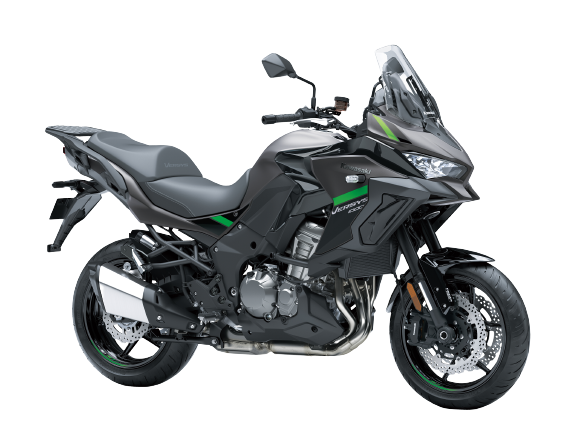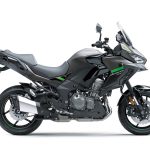Top Features

Twin LED Headlamps
Each of the new LED headlamps features low and high beams as well as a position lamp. Highly visible, the new headlamps offer significantly increased brightness to illuminate the way on night rides.

High-Class Instrumentation
New instrumentation with an advanced, high-tech design gives the Versys 1000 cockpit a very high-class appearance. The analogue-style tachometer is complemented by a full digital LCD screen

Adjustable Windscreen
Complementing the increased wind protection offered by the Versys 1000’s new front cowl and wider shrouds, the steplessly adjustable windscreen can be tailored to rider preference, contributing to comfortable highway cruising. Windscreen height can now be easily adjusted from the rider’s seat.

Radial-Mount Front Brake Calipers
The ø310 mm front petal discs are now gripped by highly rigid radial-mount monobloc calipers complemented by a radial-pump front brake master cylinder, contributing to superb feel and formidable stopping power.

KIBS (Kawasaki Intelligent anti-lock Brake System)
Kawasaki’s supersport-grade high-precision brake management system is now standard equipment on the Versys 1000. This is the same base system used on the Ninja H2 and Ninja ZX-10R, with programming and settings revised to suit the street performance parameters and long-travel suspension of the Versys 1000.

KCMF (Kawasaki Cornering Management Function)
IMU-Equipped Total Engine & Chassis Management Package
Using the latest evolution of Kawasaki’s advanced modelling software and feedback from a compact Bosch IMU (Inertial Measurement Unit), KCMF monitors engine and chassis parameters throughout the corner – from entry, through the apex, to corner exit – modulating brake force and engine power to facilitate smooth transition from acceleration to braking and back again, and to assist riders in tracing their intended line through the corner. On the Versys 1000, KCMF oversees the following systems:
KECS (SE-only feature)
KIBS (including pitching management and corner braking management)

KTRC (Kawasaki Traction Control)
KTRC (Kawasaki TRaction Control)

Upright riding position
Spacious, upright riding position offers a high level of machine control in various conditions while contributing to rider comfort.

Assist & Slipper Clutch
Race-inspired clutch technology offers both a back-torque limiting function as well as a very light feel at the lever.

Fun Sport Riding on a Variety of Streets/Conditions
Because real world riding occurs on streets that are often less than circuit smooth – road imperfections (bumps, potholes) are far from rare, and some streets are not even paved (cobblestone, etc) – Kawasaki engineers chose long-travel suspension to enable riders to carve corners with aplomb. While not designed for off-road use, the long-travel suspension’s ability to cope with less-than-perfect street conditions allows the Versys 1000 to remain composed where bikes with stiffer, sportier set-ups would require backing off the throttle. Lightweight 17” wheels front and rear contribute to quick, sporty handling.

Electronic Throttle Valves
Electronic Throttle Valves enable the ECU to control the volume of both the fuel (via fuel injectors) and the air (via throttle valves) delivered to the engine. Ideal fuel injection and throttle valve position results in smooth, natural engine response and the ideal engine output.

Exciting In-Line Four Engine
A key to the Versys 1000’s fun factor, the exciting engine delivers more than just performance figures. The 1,043 cc In-line Four, tuned for flexibility, offers superb throttle response, strong torque at all rpm (especially in the low-mid range), and a seductive intake howl – ensuring riders are treated to a physically and aurally exhilarating sensation with every twist of the throttle. A change to Electronic Throttle Valves for 2020 enables the addition of Electronic Cruise Control, while also contributing to smooth power delivery.

Handy power source
Conveniently located in the cockpit, a DC socket, previously an accessory, is now standard equipment. The socket is complemented by prepared pre-wiring. A total of 40 W of power is available.

Electronic Cruise Control
Kawasaki’s cruise control system allows a desired speed to be maintained with the simple press of a button. Once activated, the rider does not have to constantly apply the throttle. This reduces stress on the right hand when traveling long distances, enabling relaxed cruising and contributing to a high level of riding comfort.
SPECIFICATIONS
| Engine & Transmission | |
| Type | Liquid-cooled, 4-stroke In-Line Four |
| Displacement | 1,043 cc |
| Bore and Stroke | 77.0 x 56.0 mm |
| Compression ratio | 10.3:1 |
| Valve system | DOHC, 16 valves |
| Fuel system | Fuel injection: Ø 38 mm x 4 |
| Fuel Type / Minimum Octane Rating | Unleaded Petrol / RON 95 |
| Ignition | Digital |
| Starting | Electric |
| Lubrication | Forced lubrication, wet sump |
| Transmission | 6-speed, return |
| Maximum power | 88.2 kW {120 PS} / 9,000 rpm |
| Maximum power with Ram Air | — |
| Maximum torque | 102 N•m {10.4 kgf•m} / 7,500 rpm |
| Electronic Rider Aid | |
| Dimensions & Chassis | |
| Frame Type | Twin-tube, aluminium |
| Rake / Trail | 27.0° / 106 mm |
| Tyre – Front | 120/70ZR17M/C (58W) |
| Tyre – Rear | 180/55ZR17M/C (73W) |
| Wheelbase | 1,520 mm |
| Ground clearance | 150 mm |
| Seat height | 820 mm |
| Curb mass | 255 kg |
| Fuel capacity | 21 litres |
| Overall Dimensions (L x W x H) | 2,270 x 895 x 1,400 mm |
| Brakes & Suspension | |
| Front / Wheel Travel | ø43 mm inverted fork with rebound damping (right-side) and spring preload adjustability / 150 mm |
| Rear / Wheel Travel | Horizontal Back-link, gas-charged, with rebound damping and remote spring preload adjustability / 152 mm |
| Brake – Front | Dual semi-floating ø310 mm petal discs |
| Caliper – Front | Dual radial-mount, monobloc, opposed 4-piston |
| Brake – Rear | Single ø250 mm petal disc |
| Caliper – Rear | Single-piston |
















